Signs Your Roof Has Storm Damage
If you’ve recently experienced a storm, you should probably take some time to investigate your roof for signs of damage left by that storm.
In the winter season, there are all kinds of risks to your roof system. Hail could damage your shingles, snow could weigh down your gutters if they aren’t cleaned out, and perhaps worst of all, your roof could deal with an ice dam.
Ice dams sound bad and are. They can be difficult to get rid of, and can cause a load of damage to the edges of your roof if they stick around too long.
But what exactly are ice dams?
In this blog, we’ll go over:
Let’s get started!
An ice dam is a ridge or barrier of ice that forms at the edge of a roof, preventing snow and water from draining off the roof as it should. Ice dams are typically more common in regions with colder climates and heavy snowfall, but they can occur in areas like North Carolina during periods of significant winter weather.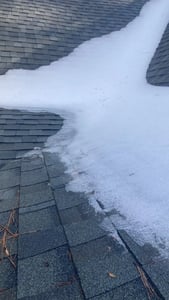
One common visual indicator of an impending ice dam is the formation of icicles along the eaves and gutters. These icicles are a sign that snow is melting on the upper part of the roof and then refreezing along the colder eaves, creating the dam.
Recognizing these signs and taking proactive steps to prevent or address ice dams, such as improving insulation and ventilation in the attic or safely removing the ice dam, can help protect your roof and home from potential damage during the winter months.
Ice dams develop when snow or ice on a roof undergoes a cycle of melting and refreezing. This process is often triggered by an attic with inadequate ventilation, which retains excess heat and causes the snow to melt from underneath. As the melted water flows towards the roof's edge, it encounters colder temperatures and refreezes.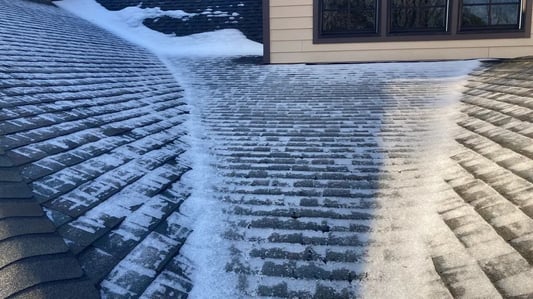
Once formed, the ice dam persists in a frozen state until the surrounding air temperature rises sufficiently to melt it. Meanwhile, the snow on the remaining part of the roof may also melt and flow towards the dam, where it can either freeze and contribute to its size or become trapped behind it. These scenarios can lead to significant issues for homeowners.
Attic ventilation is a critical component of a well-maintained roof system, and understanding how it works can help homeowners grasp its role in preventing ice dams.
Ventilation in an attic is typically achieved through a combination of intake vents and exhaust vents. The intake vents are typically located along the lower edge of the roof or in the soffit area. These vents allow fresh, cooler outdoor air to enter the attic. On the other hand, exhaust vents are positioned higher on the roof, near the ridge or at the gable ends. They serve as outlets for the warm, moist air rising from the living spaces below. This continuous airflow creates a balanced system that helps maintain consistent attic temperature and humidity levels.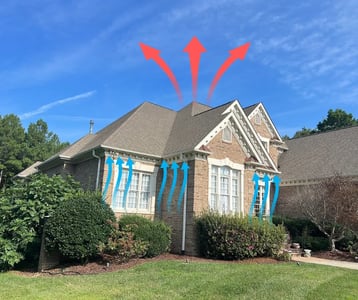
Ice dams form when heat escaping from your home's interior warms the underside of your roof, causing the snow on the roof to melt. As this melted snow runs down your roof, it reaches the colder eaves, where it refreezes, gradually building up into an ice dam. Proper attic ventilation plays a key role in this scenario by ensuring that the temperature in your attic remains consistent with the outdoor temperature. In a well-ventilated attic, the intake vents bring in cold outdoor air, while the exhaust vents expel any warm air from the living spaces. This prevents the snow on the roof from melting prematurely and reduces the likelihood of ice dam formation.
Effective attic ventilation helps maintain an even attic temperature, minimizing the conditions that contribute to ice dam formation. By regulating the temperature of the underside of your roof, proper ventilation helps protect your home from the damage caused by ice dams, such as roof leaks and structural issues.
Ice dams can lead to various troublesome issues, each with the potential for significant consequences. Water trapped behind the dam may infiltrate your roof through vulnerable points, resulting in roof leaks. Additionally, if the dam grows too large, its weight can warp or even damage your gutters and soffits, posing a serious threat to your home's integrity.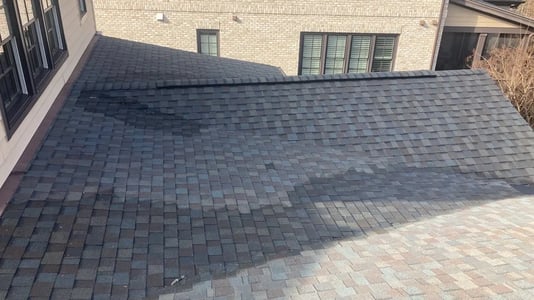
The leaks caused by these dams can also result in substantial damage to your roof's decking and the structural components within your attic. Dealing with these issues can be a challenging and costly process, particularly when it becomes necessary to undertake a roof replacement.
Maintaining clean gutters is an effective way to minimize the risk of ice dam formation during the winter season, especially before impending winter storms. Clogged gutters hinder the proper flow of water, causing trapped water to freeze and accumulate on your roof, leading to the ice dam issues we've discussed.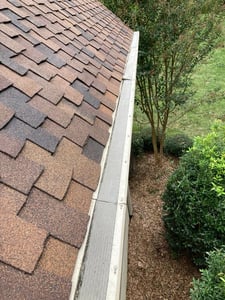
However, the benefits of clean gutters extend beyond ice dam prevention. Regular gutter maintenance also plays a crucial role in preventing other roofing problems, such as leaks and soffit damage. By ensuring clear gutters, homeowners can protect their roofs and homes from a range of potential issues.
Another precaution homeowners can take is to proactively remove snow from their roofs before it has a chance to melt. This can be done through methods such as brushing, blowing, or melting the snow. However, it's important to exercise caution when attempting snow removal yourself, especially during extremely cold weather.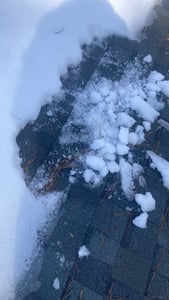
Shingles can become stiff and brittle in low temperatures, making them more susceptible to damage. Additionally, navigating a snowy or icy roof can be hazardous. In such conditions, it's safer and more effective to enlist the services of a professional roofing company with experience in snow and ice dam removal. These experts have the necessary equipment and expertise to safely and efficiently address the issue, reducing the risk of damage to your roof.
To safeguard your home from ice dams and ensure long-term protection, it's crucial to prioritize proper attic ventilation. An inadequately ventilated attic can trap excess heat, leading to elevated roof surface temperatures that initiate the ice dam formation process by melting the snow.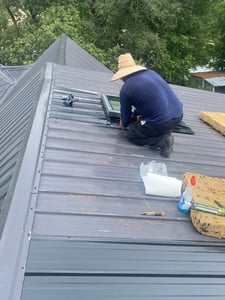
To address this issue effectively, consider consulting a professional roofing contractor. They can assess your attic's ventilation needs and determine whether your current ventilation system is sufficient to meet those requirements. Proper attic ventilation is a proactive step toward preventing ice dam formation and maintaining the integrity of your roof.
On Tops Roofing has been helping homeowners in the Raleigh, NC area with all kinds of roofing issues, since 1991. Whatever your roof requires, We're on it!
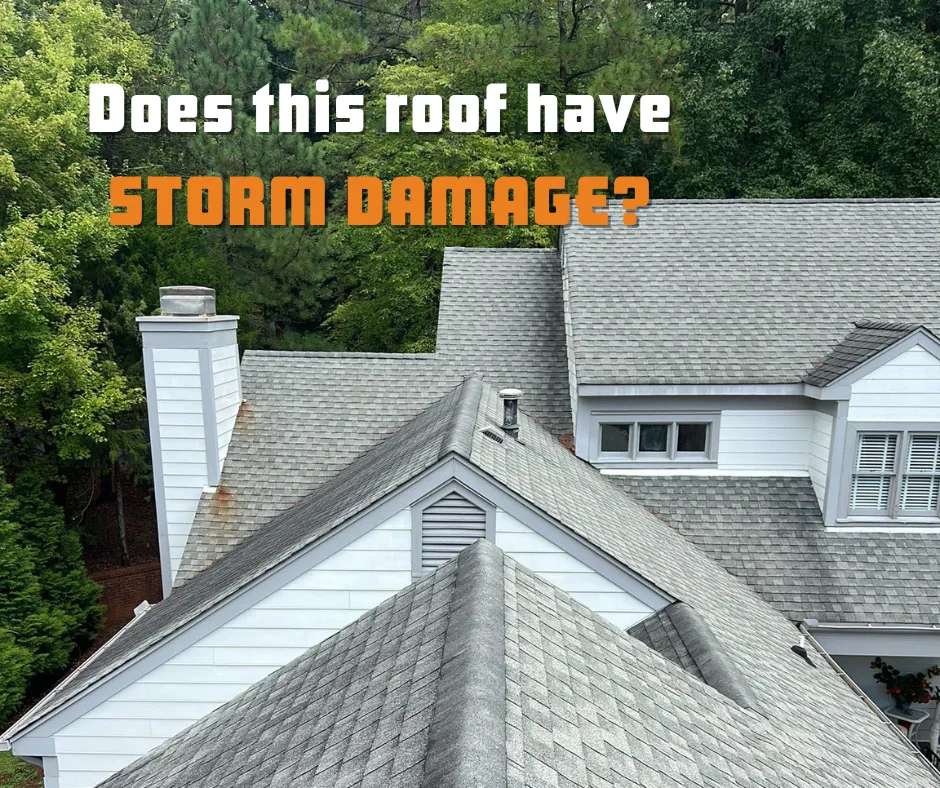
If you’ve recently experienced a storm, you should probably take some time to investigate your roof for signs of damage left by that storm.

Having a lot of trees around your home can be great for your privacy, and that lovely feeling of being out in nature. I for one am a big fan of...
.png)
When winter comes, it often brings with it some beautiful scenes. Trees become bare, creeks freeze over, and snow blankets the neighborhood.